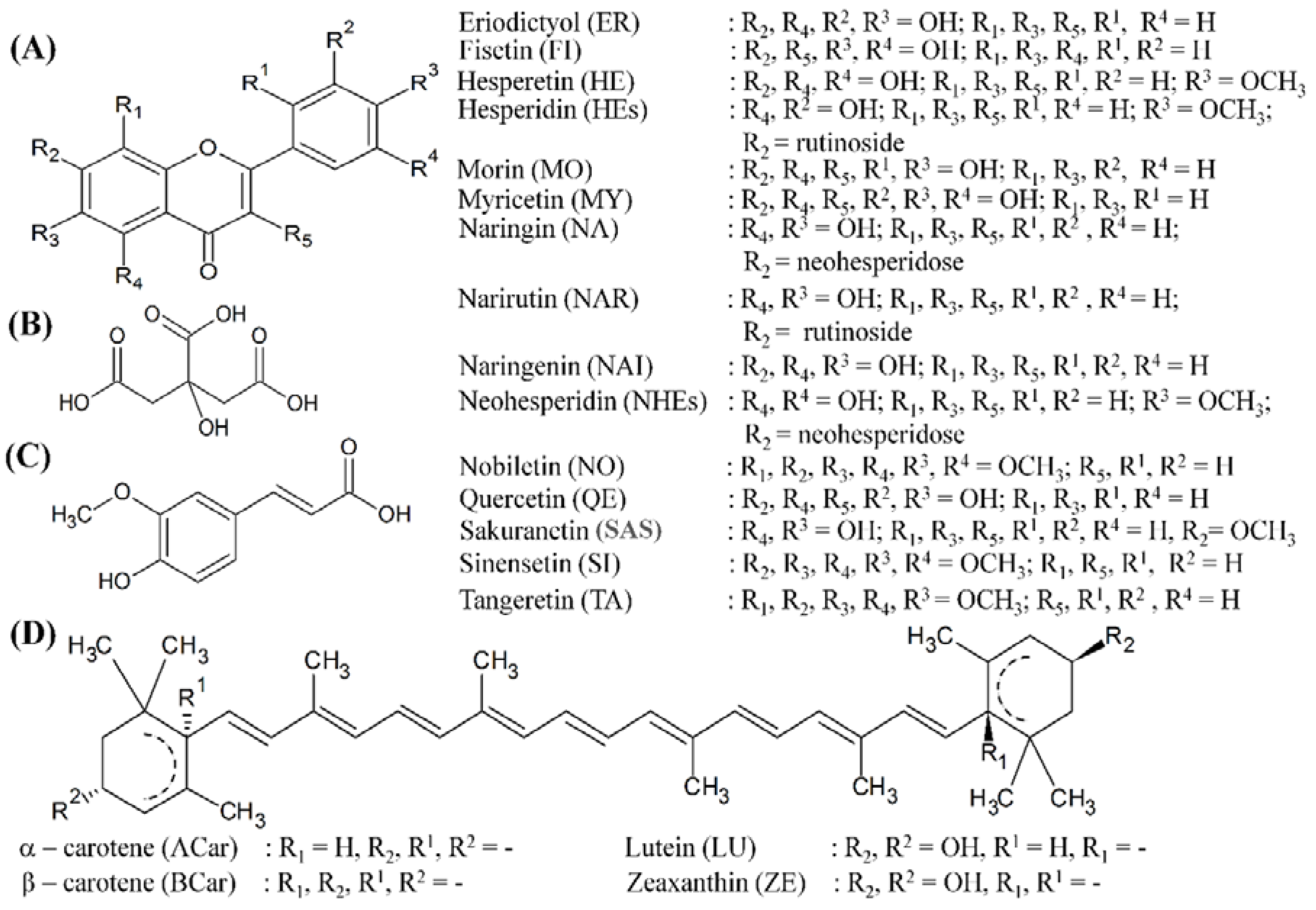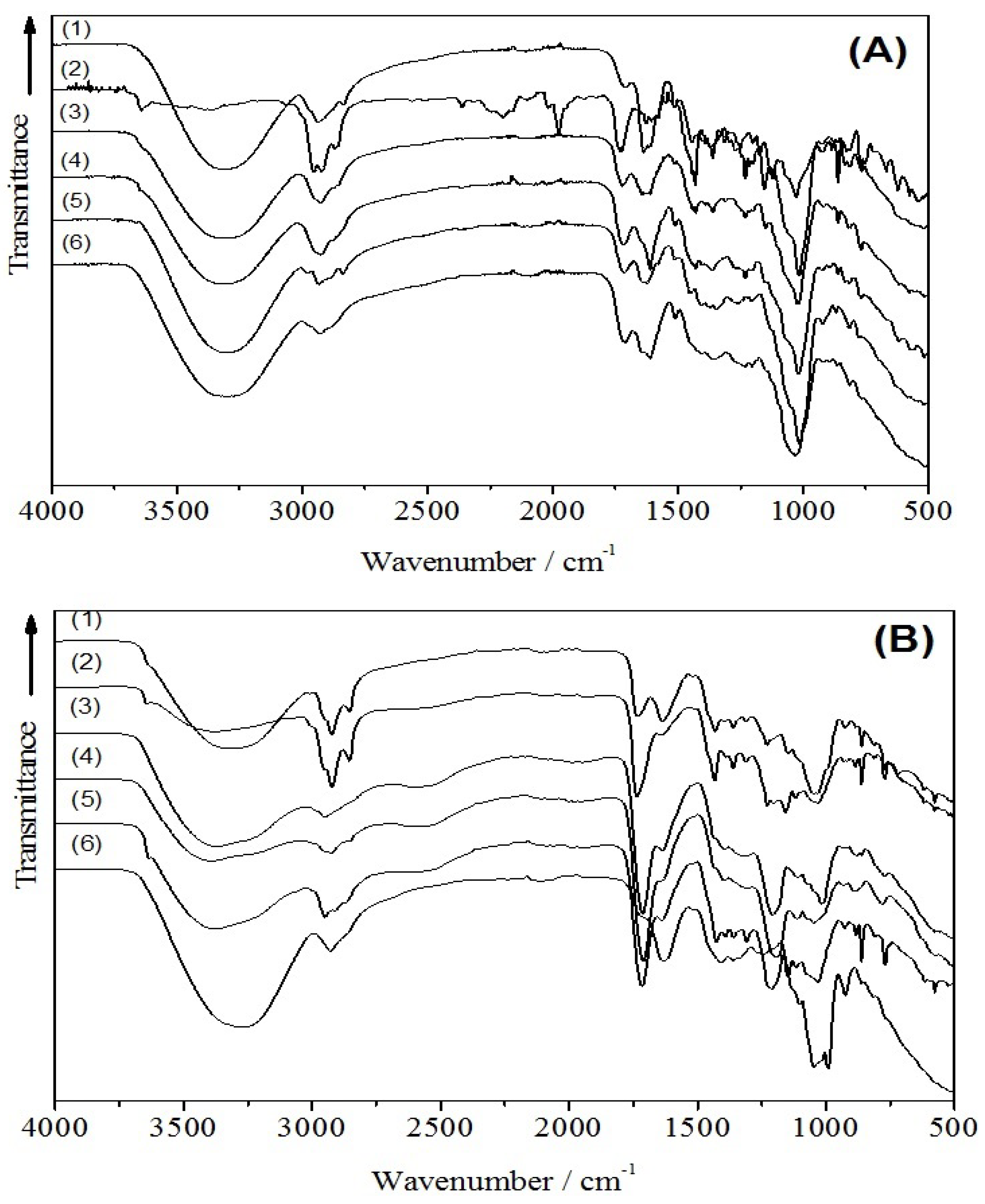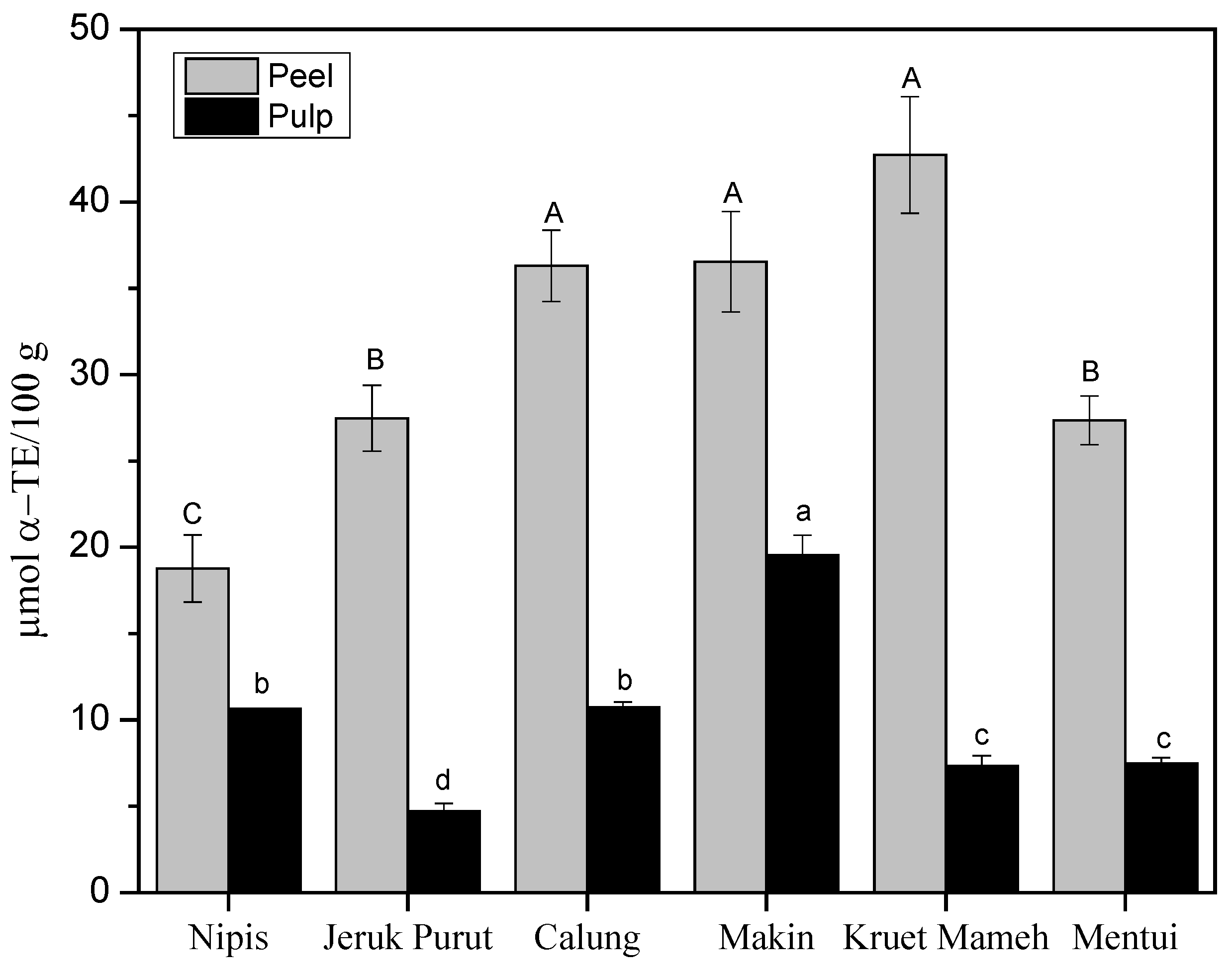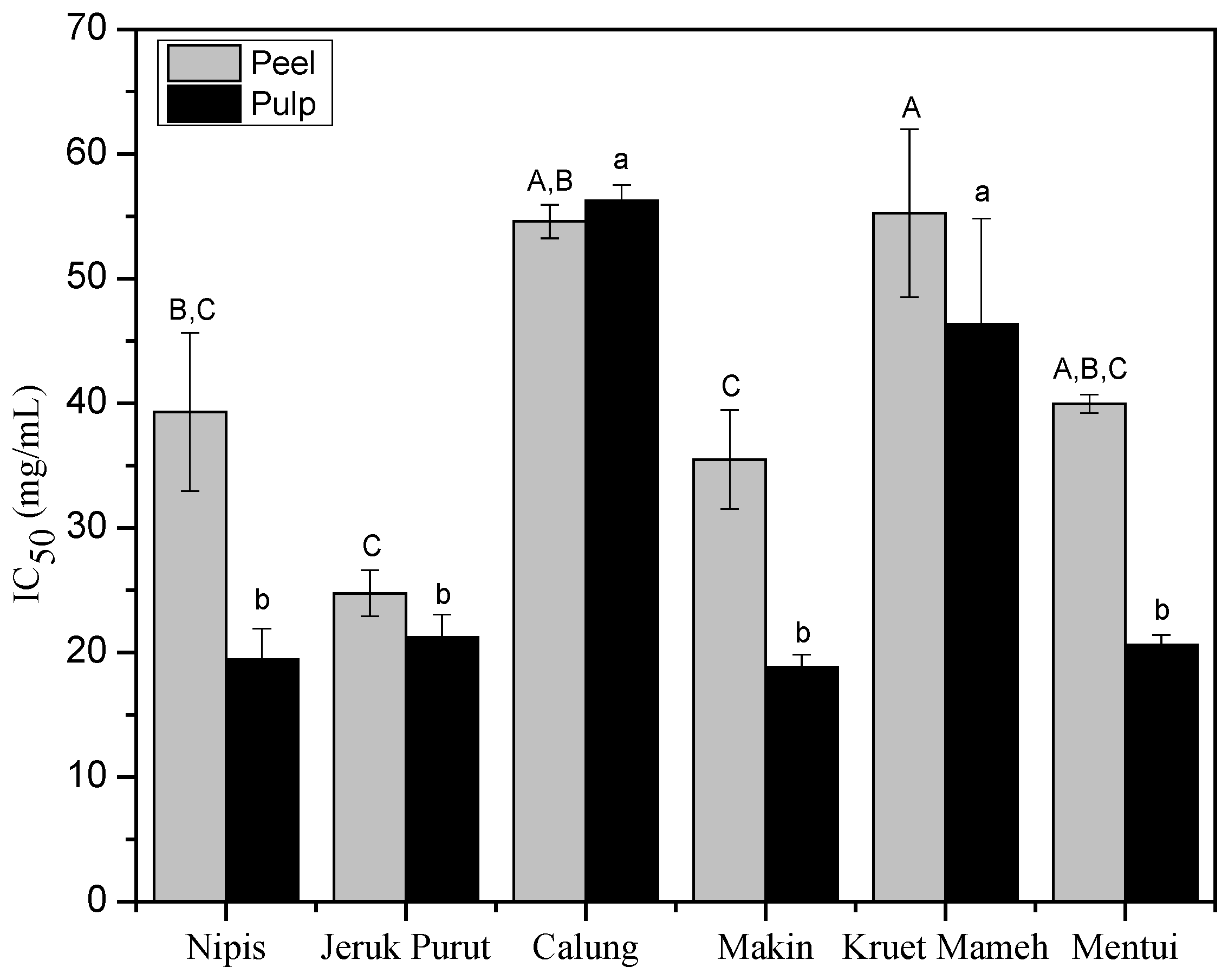In Vitro Lipophilic Antioxidant Capacity, Antidiabetic and Antibacterial Activity of Citrus Fruits Extracts from Aceh, Indonesia
Abstract
:1. Introduction
2. Materials and Methods
2.1. Chemicals
2.2. Plant Materials
2.3. Carotenoid Extractions
2.4. Polyphenol Extractions
2.5. Phytochemical Analysis
2.5.1. Phenolic Test
2.5.2. Flavonoid Test
2.5.3. Terpenoids (Salkowski Test)
2.5.4. Alkaloid Test (Wagner Test)
2.5.5. Cardiac Glycoside Test
2.6. HPLC Analysis
2.6.1. Carotenoid Analysis
2.6.2. Polyphenol Analysis
2.7. FTIR Analysis
2.8. Antioxidant Capacity
2.9. Inhibition of α-Amylase Activity
2.10. Antibacterial Activity
2.10.1. Extract Preparation
2.10.2. Preparation of Bacterial Suspensions
2.10.3. Microplate Laser Nephelometry
2.11. Statistical Analysis
3. Results and Discussion
3.1. HPLC and FTIR Analysis
3.2. Antioxidant Capacity of Citrus Samples
3.3. In vitro α-Amylase Activity of Peels and Pulps of Citrus Fruits
3.4. Antibacterial Activity of Peel and Pulp of Various Citrus from Aceh
4. Conclusions
Acknowledgments
Author Contributions
Conflicts of Interest
References
- Krishnaiah, D.; Sarbatly, R.; Nithyanandam, R. A review of the antioxidant potential of medicinal plant species. Food Bioprod. Process 2011, 89, 217–233. [Google Scholar] [CrossRef]
- Pham-Huy, L.A.; He, H.; Pham-Huy, C. Free radicals, antioxidants in disease and health. Int. J. Biomed. Sci. 2008, 4, 89–96. [Google Scholar] [PubMed]
- Yang, S.C.; Lin, C.H.; Sung, C.T.; Fang, J.Y. Antibacterial activities of bacteriocins: Application in foods and pharmaceuticals. Front. Microbiol. 2014, 5, 1–10. [Google Scholar] [CrossRef]
- Sasidharan, S.; Chen, Y.; Saravanan, D.; Sundram, K.M.; Latha, L.Y. Extraction, isolation and characterization of bioactive compounds from plants’ extracts. Afr. J. Tradit. Complement. Altern. Med. 2011, 8, 1–10. [Google Scholar] [CrossRef] [PubMed]
- Muhtadi, M.; Haryoto, H.; Azizah, T.; Suhendi, A.; Yen, K. Antidiabetic and antihypercholesterolemic activities of Citrus sinensis peel: In vivo study. Natl. J. Physiol. Pharm. Pharmacol. 2015, 5, 382–385. [Google Scholar] [CrossRef]
- Parmar, H.S.; Kar, A. Antidiabetic potential of Citrus sinensis and Punica granatum peel extracts in alloxan treated male mice. BioFactors 2007, 31, 17–24. [Google Scholar] [CrossRef] [PubMed]
- Zhang, Y.; Sun, Y.; Xi, W.; Shen, Y.; Qiao, L.; Zhong, L.; Ye, X.; Zhou, Z. Phenolic compositions and antioxidant capacities of Chinese wild mandarin (Citrus reticulata Blanco) fruits. Food Chem. 2014, 145, 674–680. [Google Scholar] [CrossRef] [PubMed]
- Abirami, A.; Nagarani, G.; Siddhuraju, P. Hepatoprotective effect of leaf extracts from Citrus hystrix and C. maxima against paracetamol induced liver injury in rats. Food Sci. Hum. Wellness 2015, 4, 35–41. [Google Scholar] [CrossRef]
- Settanni, L.; Palazzolo, E.; Guarrasi, V.; Aleo, A.; Mammina, C.; Moschetti, G.; Germanà, M.A. Inhibition of foodborne pathogen bacteria by essential oils extracted from citrus fruits cultivated in Sicily. Food Control 2012, 26, 326–330. [Google Scholar] [CrossRef]
- Meléndez-Martínez, A.J.; Britton, G.; Vicario, I.M.; Heredia, F.J. Does the carotenoid neoxanthin occur in orange juice? Food Chem. 2008, 107, 49–54. [Google Scholar] [CrossRef]
- Müller, L.; Fröhlich, K.; Böhm, V. Comparative antioxidant activities of carotenoids measured by ferric reducing antioxidant power (FRAP), ABTS bleaching assay (αTEAC), DPPH assay and peroxyl radical scavenging assay. Food Chem. 2011, 129, 139–148. [Google Scholar] [CrossRef]
- Peterson, J.J.; Dwyer, J.T.; Beecher, G.R.; Bhagwat, S.A.; Gebhardt, S.E.; Haytowitz, D.B.; Holden, J.M. Flavanones in oranges, tangerines (mandarins), tangors, and tangelos: A compilation and review of the data from the analytical literature. J. Food Comp. Anal. 2006, 19, 66–73. [Google Scholar] [CrossRef]
- Hamdan, D.I.; Mahmoud, M.F.; Wink, M.; El-Shazly, A.M. Effect of hesperidin and neohesperidin from bittersweet orange (Citrus aurantium var. bigaradia) peel on indomethacin-induced peptic ulcer in rats. Environ. Toxicol. Pharmacol. 2014, 37, 907–915. [Google Scholar] [CrossRef] [PubMed]
- Donna, L.D.; Iacopetta, D.; Capello, A.R.; Galucci, G.; Martello, E.; Fiorillo, M.; Dolce, V.; Sindonna, G. Hypocholesterolaemic activity of 3-hydroxy-3-methyl-glutaryl flavanones enriched fraction from bergamot fruit (Citrus bergamia): “In vivo” studies. J. Funct. Foods 2014, 7, 558–568. [Google Scholar] [CrossRef]
- Jung, U.J.; Lee, M.-K.; Park, Y.B.; Kang, M.A.; Choi, M.-S. Effect of citrus flavonoids on lipid metabolism and glucose-regulating enzyme mRNA levels in type-2 diabetic mice. Int. J. Biochem. Cell Biol. 2006, 38, 1134–1145. [Google Scholar] [CrossRef] [PubMed]
- Gyo-Nam, K.; Jung-Geun, S.; Hae-Dong, J. Antioxidant and antidiabetic activity of Dangyuja (Citrus grandis Osbeck) extract treated with Aspergillus saitoi. Food Chem. 2009, 117, 35–41. [Google Scholar]
- Miyake, Y.; Minato, K.; Fukumoto, S.; Yamamoto, K.; Oya-Ito, T.; Kawakishi, S.; Osawa, T. New potent antioxidative hydroxyflavanones produced with Aspergillus saitoi from flavanone glycoside in citrus fruit. Biosci. Biotechnol. Biochem. 2003, 67, 1443–1450. [Google Scholar] [CrossRef] [PubMed]
- Tadera, K.; Minami, Y.; Takamatsu, K.; Matsuoka, T. Inhibition of α-Glucosidase and α-Amylase by Flavonoids. J. Nutr. Sci. Vitaminol. 2006, 52, 149–153. [Google Scholar] [CrossRef] [PubMed]
- Ernawita; Wahyuono, R.A.; Hesse, J.; Hipler, U.-C.; Elsner, P.; Böhm, V. Carotenoids of indigenous citrus species from Aceh and its in vitro antioxidant, antidiabetic and antibacterial activities. Eur. Food Res. Technol. 2016, 242, 1869–1881. [Google Scholar] [CrossRef]
- Seybold, C.; Fröhlich, K.; Bitsch, R.; Otto, K.; Böhm, V. Changes in contents of carotenoids and vitamin E during tomato processing. J. Agric. Food Chem. 2004, 52, 7005–7010. [Google Scholar] [CrossRef] [PubMed]
- Bauerfeind, J.; Hintze, V.; Kschonsek, J.; Killenberg, M.; Böhm, V. Use of photochemiluminescence for the determination of antioxidant activities of carotenoids and antioxidant capacities of selected tomato products. J. Agric. Food Chem. 2014, 62, 7452–7459. [Google Scholar] [CrossRef] [PubMed]
- Abad-García, B.; Berrueta, L.A.; López-Márquez, D.M.; Crespo-Ferrer, I.; Gallo, B.; Vicente, F. Optimization and validation of a methodology based on solvent extraction and liquid chromatography for the simultaneous determination of several polyphenolic families in fruit juices. J. Chromatogr. A 2007, 1154, 87–96. [Google Scholar] [CrossRef] [PubMed]
- Heneczkowski, M.; Kopacz, M.; Nowak, D.; Kuzniar, A. Infrared spectrum analysis of some flavonoids. Acta Pol. Pharm. 2001, 58, 415–420. [Google Scholar] [PubMed]
- Galvez, A.; Iglesias, A. Efficient particle swarm optimization approach for data fitting with free knot B-splines. Comput. Aided Des. 2011, 43, 1683–1692. [Google Scholar] [CrossRef]
- Apostolidis, E.; Kwon, Y.-I.; Shetty, K. Inhibitory potential of herb, fruit, and fungal-enriched cheese against key enzymes linked to type 2 diabetes and hypertension. Innov. Food Sci. Emerg. 2007, 8, 46–54. [Google Scholar] [CrossRef]
- Finger, S.; Wiegand, C.; Buschmann, H.-J.; Hipler, U.-C. Antimicrobial properties of cyclodextrin-antiseptics-complexes determined by microplate laser nephelometry and ATP bioluminescence assay. Int. J. Pharm. 2012, 436, 851–856. [Google Scholar] [CrossRef] [PubMed]
- Bocco, A.; Cuvelier, M.-E.; Richard, H.; Berset, C. Antioxidant Activity and Phenolic Composition of Citrus Peel and Seed Extracts. J. Agric. Food Chem. 1998, 46, 2123–2129. [Google Scholar] [CrossRef]
- Zou, Z.; Xi, W.; Hu, Y.; Nie, C.; Zhou, Z. Antioxidant activity of Citrus fruits. Food Chem. 2015, 196, 885–896. [Google Scholar] [CrossRef] [PubMed]
- Oikeh, E.I.; Omoregie, E.S.; Oviasogie, F.E.; Oriakhi, K. Phytochemical, antimicrobial, and antioxidant activities of different citrus juice concentrates. Food Sci. Nutr. 2016, 4, 103–109. [Google Scholar] [CrossRef] [PubMed]
- Abirami, A.; Nagarani, G.; Siddhuraju, P. In vitro antioxidant, anti-diabetic, cholinesterase and tyrosinase inhibitory potential of fresh juice from Citrus hystrix and C. maxima fruits. Food Sci. Hum. Wellness 2014, 3, 16–25. [Google Scholar] [CrossRef]
- Uddin, N.; Hasan, M.R.; Hossain, M.M.; Sarker, A.; Hasan, A.H.M.N.; Islam, A.F.M.M.; Chowdhury, M.M.; Rana, M.S. In vitro α–amylase inhibitory activity and in vivo hypoglycemic effect of methanol extract of Citrus macroptera Montr. fruit. Asian Pac. J. Trop. Biomed. 2014, 4, 473–479. [Google Scholar] [CrossRef] [PubMed]
- Tundis, R.; Loizzo, M.R.; Menichini, F. Natural Products as α-Amylase and α-Glucosidase Inhibitors and their Hypoglycaemic Potential in the Treatment of Diabetes: An Update. Mini Rev. Med. Chem. 2010, 10, 315–331. [Google Scholar] [CrossRef] [PubMed]
- Mohamed, E.A.H.; Siddiqui, M.J.A.; Ang, L.F.; Sadikun, A.; Chan, S.H.; Tan, S.C.; Asmawi, M.Z.; Yam, M.F. Potent alpha-glucosidase and alpha-amylase inhibitory activities standardized 50% ethanolic extracts and sinensetin from Orthosiphon stamineus Benth as anti-diabetic mechanism. BMC Complement. Altern. Med. 2012, 12, 176. [Google Scholar] [CrossRef] [PubMed]
- Wu, T.; Cheng, D.; He, M.; Pan, S.; Yao, X.; Xu, X. Antifungal action and inhibitory mechanism of polymethoxylated flavones from Citrus reticulata Blanco peel against Aspergillus niger. Food Control 2014, 35, 354–359. [Google Scholar] [CrossRef]
- Yi, Z.; Yu, Y.; Liang, Y.; Zeng, B. In vitro antioxidant and antimicrobial activities of the extract of Pericarpium Citri Reticulatae of a new Citrus cultivar and its main flavonoids. LWT Food Sci. Technol. 2008, 41, 597–603. [Google Scholar] [CrossRef]
- Tomotake, H.; Koga, T.; Yamato, M.; Kassu, A.; Ota, F. Antibacterial activity of citrus fruit juices against Vibrio species. J. Nutr. Sci. Vitaminol. 2006, 52, 157–160. [Google Scholar] [CrossRef] [PubMed]
- Thilakarathna, S.H.; Vasantha Rupasinghe, H.P. Flavonoid bioavailability and attempts for bioavailability enhancement. Nutrients 2013, 5, 3367–3387. [Google Scholar] [CrossRef] [PubMed]
- Vallejo, F.; Larrosa, M.; Escudero, E.; Zafrilla, M.P.; Cerda, B.; Boza, J.; García-Conesa, M.T.; Espin, J.C.; Tomás-Barberán, F.A. Concentration and solubility of flavanones in orange beverages affect their bioavailability in humans. J. Agric. Food Chem. 2010, 58, 6516–6524. [Google Scholar] [CrossRef] [PubMed]
- Parker, R.S.; Swanson, J.E.; You, C.S.; Edwards, A.J.; Huang, T. Bioavailability of carotenoids in human subjects. Proc. Nutr. Soc. 1999, 58, 155–162. [Google Scholar] [CrossRef] [PubMed]
- Burri, B.J.; La Frano, M.R.; Zhu, C. Absorption, metabolism, and functions of β-cryptoxanthin. Nutr. Rev. 2016, 74, 69–82. [Google Scholar] [CrossRef] [PubMed]





| No. | Compound | Class | WL (nm) | RT (min) | Max. WL (nm) | Concentration (mg/100 g FW) in | |||||||||||
|---|---|---|---|---|---|---|---|---|---|---|---|---|---|---|---|---|---|
| Jeruk Nipis | Jeruk Purut | Calung | Makin | Kruet Mameh | Mentui | ||||||||||||
| Peel | Pulp | Peel | Pulp | Peel | Pulp | Peel | Pulp | Peel | Pulp | Peel | Pulp | ||||||
| 1 | Gallic acid | HBA | 254 | 11.4 ± 0.0 | 273 | 11 ± 2 | n.d. | 8.3 ± 0.3 | 1.5 ± 0.1 | 14 ± 2 | 2.3 ± 0.1 | 13 ± 3 | 2.6 ± 0.0 | 7.2 ± 0.4 | 4.1 ± 2.1 | 7.8 ± 0.9 | 0.9 ± 0.0 |
| 2 | Caffeic acid | HCA | 320 | 30.5 ± 0.0 | 297, 323 | 4.6 ± 2.2 | n.d. | n.d. | n.d. | 13 ± 1 | 1.5 ± 0.0 | 4.8 ± 0.2 | n.d. | 22 ± 0 | 2.3 ± 0.3 | n.d. | n.d. |
| 3 | Ferulic acid | HCA | 320 | 55.5 ± 0.1 | 290, 320 | 2.8 ± 0.1 | n.d. | 3.4 ± 0.2 | n.d. | 53 ± 1 | 3.4 ± 0.1 | 3.8 ± 0.7 | n.d. | 24 ± 1 | 3.4 ± 1.0 | 2.0 ± 0.2 | n.d. |
| 4 | Narirutin | FVN | 280 | 81.3 ± 0.0 | 274 | n.d. | n.d. | n.d. | n.d. | n.d. | n.d. | n.d. | n.d. | n.d. | n.d. | n.d. | n.d. |
| 5 | Naringin | FVN | 280 | 86.4 ± 0.3 | 286, 334 | n.d. | n.d. | n.d. | n.d. | 952 ± 63 | 271 ± 10 | n.d. | n.d. | n.d. | n.d. | n.d. | n.d. |
| 6 | Hesperidin | FVN | 280 | 91.0 ± 0.1 | 285, 333 | 299 ± 17 | 71 ± 1 | 130 ± 5 | 74 ± 7 | n.d. | n.d. | 232 ± 10 | 103 ± 11 | 1422 ± 36 | 338 ± 7 | 29 ± 1 | 23 ± 0 |
| 7 | Neohesperidin | FVN | 280 | 95.5 ± 0.1 | 285, 333 | n.d. | n.d. | 150 ± 4 | 75 ± 4 | 1137 ± 56 | 158 ± 1 | 233 ± 14 | 123 ± 15 | n.d. | n.d. | 114 ± 8 | 51 ± 2 |
| 8 | Sinensetin | FLV | 320 | 150.8 ± 0.0 | 242, 266 *, 332 | 0.3 ± 0.1 | n.d. | n.d. | n.d. | 2.7 ± 1.5 | 0.2 ± 0.0 | 1.6 ± 0.1 | n.d. | 3.0 ± 0.3 | n.d. | n.d. | n.d. |
| 9 | Nobiletin | FLV | 320 | 152.9 ± 0.0 | 251, 271, 334 | 0.4 ± 0 | n.d. | n.d. | n.d. | 24 ± 1 | n.d. | 7.8 ± 0.4 | n.d. | 39 ± 1 | n.d. | n.d. | n.d. |
| 10 | Tangeretin | FLV | 320 | 154.7 ± 0.0 | 272, 334 | 2.4 ± 0.1 | n.d. | n.d. | n.d. | 7.7 ± 0.4 | 0.9 ± 0.0 | 4.7 ± 0.1 | n.d. | 5.1 ± 0.2 | n.d. | n.d. | n.d. |
| Functional group | Peel | Pulp | ||||||||||
|---|---|---|---|---|---|---|---|---|---|---|---|---|
| Calung | Makin | Mentui | Jeruk Nipis | Jeruk Purut | Kruet Mameh | Calung | Makin | Mentui | Jeruk Nipis | Jeruk Purut | Kruet Mameh | |
| O–H stretching | 3320 | 3644.1; 3358.6 | 3294.7 | 3315.6 | 3300.1 | 3311.1 | 3000.2 | 3642.2; 3371.9 | 3377.3 | 3397 | 3635.9; 3389.2 | 3260.7 |
| CH2 vibration | 2937.3; 2831.7 | 2952.9; 2922.4 | 2925.1 | 2925.5 | 2977.3; 2831.7 | 2930 | 2922.9; 2854.1 | 2922.8; 2854 | 2949.8 | 2925.5; 2844.3 | 2951.3 | 2927.8 |
| COO stretching | 1704.5 | 1725.5 | 1720.3 | 1719.2 | 1716.3 | 1710.3 | 1736.1 | 1734.4 | 1713 | 1809.9 | 1716.4 | |
| C=O stretching | 1636 | 1625.7; 1605.1 | 1638.6 | 1611 | 1623.2 | 1610.1 | 1637.1 | 1638 | 1628.5 | 1634.8 | 1628.6 | |
| C=C vibration | 1511.4; 1441.7; 1400.5 | 1547.4; 1441.1; 1430.7 | 1429.7 | 1511.4; 1429.7 | 1511.4; 1444.9 | 1510 | 1429.8 | 1430.5; 1389.8 | 1394.2 | 1397.4 | 1428.1; 1388.8 | 1406.1 |
| CH bending | 1369.4; 1271.5 | 1360.4; 1314.1 | 1359.5 | 1362.8 | 1347.5 | 1355.3 | 1359.8; 1305.5 | 1360.8; 1313.4 | 1315.1 | 1357.8; 1308.4 | 1362.5 | |
| COO vibration | 1197.9; 1173.4 | 1230.8; 1214.3; 1155.4 | 1230.3 | 1230.5 | 1204.2 | 1204.0 | 1230; 1144.1 | 1230.0; 1214.2; 1191.6 | 1208.3 | 1196.9; 1108.1 | 1213.3; 1147.2; 1118.9 | 1232.7; 1197.9; 1102.9 |
| C–O–C vibration | 1016.6 | 1026.7 | 1021.7 | 1018.3 | 1015 | 1030.8 | 1050.1 | 1025.6 | 1015.4 | 1047.5 | 1025.1 | 1046.9 |
| Finger print zone | 919.3; <812.7 | 919.2; <885.9 | 860.27; <767.8 | 922.4; <887.6 | 916.1; <862.3 | <920 | 925.1; <860.3 | 935.1; <885.6 | 881.9 | 881.42 | 929.1; <884.3 | 991.3; 924 |
| Flavonoid, phenolic acid and carotenoid contents * (value in brackets indicate percentage) | BCar (16), CA (0.6), ER (7), FA (4), FI (2), HE (7), HEs (5), LU (4), NA (14), NAI (4), NHEs (5), NO (0.6), QE (7), SA (2), SI (1), TA (16), ZE (4) | BCar (13), CA (4), FA (1), HE (6), HEs (6), LU (10), NAI (7), NHEs (12), SI (0.5), TA (42) | BCar (7), CA (4), FA (7), FI (2), HEs (8), LU (20), NA (10), NAI (6), NAR (3), NHEs (4), MO (2), MY (2), QE (7), SA (1), TA (15), ZE (6) | CA (4), FA (0.5), HEs (11), LU (13) NA (12), NO (5.5), QE (14), SA (18), SI (1), TA (21) | CA (2.7), FA (2.7), HEs (22.4), LU (7), NA (20.3), NHEs (11.7), NO (4.3), SA (3), TA (25.6), ZE (0.3) | ACar (2.5), BCar (1.5), CA (4.7), ER (3.5), FA (2.4), FI (15), HEs (2), LU (11.5), NA (13), NAI (1), NAR (4), QE (9.8), SA (6), SI (2), TA (21), ZE (0.2) | ACar (4), CA (5), ER (13), FA (6), HE (4), HEs (1) LU (16), NA (11), NAI (3), NHEs (2.3), QE (5), SA (5), SI (2), TA (22) | BCar (12.7), CA (12), HEs (12), LU (12), MY (5.5), NA (3), NAI (5.5), NAR (5.5), NHEs (14), TA (25) | CA (16), FA (10), FI (3.3), HEs (2), LU (5), NA (13), NHEs (18), NO (1), SA (2.3), SI (4), TA (16), ZE (9.5) | BCar (4.8), CA (15.6), FA (6.7), HE (3), HEs (5), LU (6.8), MO (3), QE (1.4), SA (31), TA (19.6), ZE (2) | BCar (7), CA (13.8), ER (5), FA (8), HEs (4.4), LU (11.7), NA (8.3), NHEs (20.4), NO (5), MY (3.6), QE (4.9), TA (7.7) | CA (6.6), FA (3), FI (3.3), HE (3), HEs (11), LU (4), MO (3.3), NA (17.2), NHEs (2), QE (6.7), SA (3.7), SI (12), TA (20.2), ZE (4) |
| Sample | Phenolics | Flavonoids | Terpenoid | Alkaloid | Cardiac glycoside | |||||
|---|---|---|---|---|---|---|---|---|---|---|
| Peel | Pulp | Peel | Pulp | Peel | Pulp | Peel | Pulp | Peel | Pulp | |
| Jeruk Nipis | + | + | + | + | + | + | − | − | + | + |
| Jeruk Purut | + | + | + | + | + | + | − | − | + | + |
| Calung | + | + | + | + | + | + | + | − | + | + |
| Makin | + | + | + | + | + | + | − | − | + | + |
| Kruet Mameh | + | − | + | + | + | + | − | − | + | + |
| Mentui | + | + | + | + | + | + | − | − | + | + |
| Sample | Peel | Pulp | ||||||
|---|---|---|---|---|---|---|---|---|
| K. pneumoniae | Activity | S. aureus | Activity | K. pneumoniae | Activity | S. aureus | Activity | |
| Jeruk Nipis | 4.2 ± 1.8a | Bactericide | 3.5 ±1.4a,b | Bacteriostatic | 4.1 ± 0.4a,b | Bactericide | 3.1 ± 0.6a,b | Bactericide |
| Jeruk Purut | 4.6 ± 1.2a | Bacteriostatic | 4.8 ± 1.7a,b | Bactericide | 5.5 ± 1.1a,b | Bactericide | 3.4 ± 0.9a,b | Bactericide |
| Calung | 5.6 ± 0.7a | Bacteriostatic | 7.0 ± 1.9b | Bacteriostatic | 7.5 ± 1.1b | Bactericide | 6.2 ± 2.0b | Bacteriostatic |
| Makin | 4.1 ± 0.9a | Bacteriostatic | 2.5 ± 0.5a | Bactericide | 3.3 ± 0.3a | Bactericide | 2.6 ± 0.6a | Bactericide |
| Kruet Mameh | 4.3 ± 0.9a | Bactericide | 4.1 ± 1.0a,b | Bactericide | 6.8 ± 2.5a,b | Bacteriostatic | 4.7 ± 1.5a,b | Bacteriostatic |
| Mentui | 11.6 ± 3.5b | Bacteriostatic | 4.8 ± 1.8a,b | Bacteriostatic | 6.3 ± 1.0a,b | Bacteriostatic | 4.1 ± 0.5a,b | Bacteriostatic |
© 2017 by the authors. Licensee MDPI, Basel, Switzerland. This article is an open access article distributed under the terms and conditions of the Creative Commons Attribution (CC BY) license ( http://creativecommons.org/licenses/by/4.0/).
Share and Cite
Ernawita; Wahyuono, R.A.; Hesse, J.; Hipler, U.-C.; Elsner, P.; Böhm, V. In Vitro Lipophilic Antioxidant Capacity, Antidiabetic and Antibacterial Activity of Citrus Fruits Extracts from Aceh, Indonesia. Antioxidants 2017, 6, 11. https://doi.org/10.3390/antiox6010011
Ernawita, Wahyuono RA, Hesse J, Hipler U-C, Elsner P, Böhm V. In Vitro Lipophilic Antioxidant Capacity, Antidiabetic and Antibacterial Activity of Citrus Fruits Extracts from Aceh, Indonesia. Antioxidants. 2017; 6(1):11. https://doi.org/10.3390/antiox6010011
Chicago/Turabian StyleErnawita, Ruri Agung Wahyuono, Jana Hesse, Uta-Christina Hipler, Peter Elsner, and Volker Böhm. 2017. "In Vitro Lipophilic Antioxidant Capacity, Antidiabetic and Antibacterial Activity of Citrus Fruits Extracts from Aceh, Indonesia" Antioxidants 6, no. 1: 11. https://doi.org/10.3390/antiox6010011





